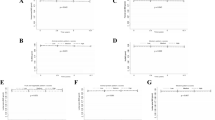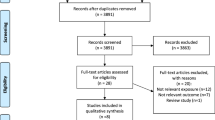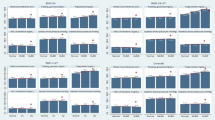Abstract
Background/Objectives:
The aim of this study was to investigate the association between dietary patterns and bone mineral density (BMD) in postmenopausal women with osteoporosis.
Subjects/Methods:
This cross-sectional study included 156 postmenopausal and osteoporotic Brazilian women aged over 45 years. BMD of lumbar spine, total femur (TF), femoral neck and of total body (TB), as well as body composition (fat and lean mass), was assessed by dual-energy X-ray absorptiometry. Body mass index and lifestyle information were also obtained. Dietary intake was assessed by using a 3-day food diary. Dietary patterns were obtained by principal component factor analysis. Adjusted multiple linear regression analysis was applied in order to evaluate the predictive effect of dietary patterns on BMD. Significance was set at P<0.05.
Results:
Five patterns were retained: ‘healthy’, ‘red meat and refined cereals’, ‘low-fat dairy’, ‘sweet foods, coffee and tea’ and ‘Western’. The ‘sweet foods, coffee and tea’ pattern was inversely associated with TF BMD (β=−0.178; 95% CI: −0.039 to −0.000) and with TB BMD (β=−0.320; 95% CI: −0.059 to −0.017) even after adjusting for energy and calcium intake, lean mass, age and postmenopausal time.
Conclusions:
A concomitant excessive consumption of sweet foods and caffeinated beverages appears to exert a negative effect on BMD even when the skeleton already presents some demineralization. Food and beverage intake is a modifiable factor that should not be neglected in the treatment of individuals with osteoporosis.
This is a preview of subscription content, access via your institution
Access options
Subscribe to this journal
Receive 12 print issues and online access
$259.00 per year
only $21.58 per issue
Buy this article
- Purchase on Springer Link
- Instant access to full article PDF
Prices may be subject to local taxes which are calculated during checkout
Similar content being viewed by others
References
Johnell O, Kanis JA . An estimate of the worldwide prevalence and disability associated with osteoporotic fractures. Osteoporos Int 2006; 17: 1726–1733.
Kanis JA . Assessment of Osteoporosis at the Primary Health-Care Level Technical Report University of Sheffield. World Health Organization: UK, 2007.
Pinheiro MM, Ciconelli RM, Jacques Nde O, Genaro PS, Martini LA, Ferraz MB . The burden of osteoporosis in Brazil: regional data from fractures in adult men and women—the Brazilian Osteoporosis Study (BRAZOS). Rev Bras Reumatol 2010; 50: 113–127.
Bortolon PC, Andrade CL, Andrade CA . Characteristics of hospital admissions in the Unified National Health System for osteoporotic hip fracture in elderly people in Brazil, 2006-2008. Cad Saude Publica 2011; 27: 733–742.
Bonjour JP, Gueguen L, Palacios C, Shearer MJ, Weaver CM . Minerals and vitamins in bone health: the potential value of dietary enhancement. Br J Nutr 2009; 101: 1581–1596.
Hu FB . Dietary pattern analysis: a new direction in nutritional epidemiology. Curr Opin Lipidol 2002; 13: 3–9.
National Research Council—Committee on Diet and Health Diet and Health: Implications for Reducing Chronic Disease Risk. National Academy Press: Washington, DC, 1989.
McNaughton SA, Wattanapenpaiboon N, Wark JD, Nowson CA . An energy-dense, nutrient-poor dietary pattern is inversely associated with bone health in women. J Nutr 2011; 141: 1516–1523.
Whittle CR, Woodside JV, Cardwell CR, McCourt HJ, Young IS, Murray LJ et al. Dietary patterns and bone mineral status in young adults: the Northern Ireland Young Hearts Project. Br J Nutr 2012; 108: 1494–1504.
Fairweather-Tait SJ, Skinner J, Guile GR, Cassidy A, Spector TD, MacGregor AJ . Diet and bone mineral density study in postmenopausal women from the TwinsUK registry shows a negative association with a traditional English dietary pattern and a positive association with wine. Am J Clin Nutr 2011; 94: 1371–1375.
Karamati M, Jessri M, Shariati-Bafghi SE, Rashidkhani B . Dietary patterns in relation to bone mineral density among menopausal Iranian women. Calcif Tissue Int 2012; 91: 40–49.
Hardcastle AC, Aucott L, Fraser WD, Reid DM, Macdonald HM . Dietary patterns, bone resorption and bone mineral density in early post-menopausal Scottish women. Eur J Clin Nutr 2011; 65: 378–385.
Tucker KL, Chen H, Hannan MT, Cupples LA, Wilson PW, Felson D et al. Bone mineral density and dietary patterns in older adults: the Framingham Osteoporosis Study. Am J Clin Nutr 2002; 76: 245–252.
Cauley JA, Danielson ME, Boudreau RM, Forrest KY, Zmuda JM, Pahor M et al. Inflammatory markers and incident fracture risk in older men and women: the Health Aging and Body Composition Study. J Bone Miner Res 2007; 22: 1088–1095.
Shin S, Joung H . A dairy and fruit dietary pattern is associated with a reduced likelihood of osteoporosis in Korean postmenopausal women. Br J Nutr 2013; 110: 1926–1933.
Langsetmo L, Hanley DA, Prior JC, Barr SI, Anastassiades T, Towheed T et al. Dietary patterns and incident low-trauma fractures in postmenopausal women and men aged >/= 50 y: a population-based cohort study. Am J Clin Nutr 2011; 93: 192–199.
Okubo H, Sasaki S, Horiguchi H, Oguma E, Miyamoto K, Hosoi Y et al. Dietary patterns associated with bone mineral density in premenopausal Japanese farmwomen. Am J Clin Nutr 2006; 83: 1185–1192.
Wosje KS, Khoury PR, Claytor RP, Copeland KA, Hornung RW, Daniels SR et al. Dietary patterns associated with fat and bone mass in young children. Am J Clin Nutr 2010; 92: 294–303.
Macdonald HM, Hardcastle AC . Dietary patterns and bone health. In: Burckhardt P, Dawson-Hughes B, Weaver CM Nutritional Influences on Bone Health. Springer. pp 135–143, 2010.
Brandao CM, Camargos BM, Zerbini CA, Plapler PG, Mendonca LM, Albergaria BH et al. 2008 official positions of the Brazilian Society for Clinical Densitometry—SBDens. Arq Bras Endocrinol Metabol 2009; 53: 107–112.
ISCD—The International Society For Clinical Densitometry The Official Positions 2013.
Fisberg RM, Slater B, Marchioni DML, Martini LA . Inquéritos Alimentares: Métodos e Bases Científicos. Manole: Barueri, 2005.
World Health Oraganization: Physical status: the use and interpretation of anthropometry Report of a WHO Expert Committee. WHO: Geneva, 1995.
Organización Panamericana de la Salud División de Promoción y Protección de la Salud (HPP) Encuesta multicentrica salud bienestar y envejecimiento (SABE) en América Latina: informe preliminar Multicenter survey aging, health and wellbeing in Latin América and the Caribbean (SABE): preliminary report. Reunión del Comité Asesor de Investigaciónes en Salud: Kingston, Washington, DC. p 19, 2001.
Hair J Jr, Black W, Babin B, Anderson R, Tatham R . Multivariate Data Analysis. 6th ed, Prentice Hall: New York, NY, 2006.
Food and Nutrition Board, Institute of Medicine Phosphorus Dietary Reference Intakes: Calcium, Phosphorus, Magnesium, Vitamin D, and Fluoride. National Academy Press: Washington, DC. pp 146–189, 1997.
Park SJ, Joo SE, Min H, Park JK, Kim Y, Kim SS et al. Dietary patterns and osteoporosis risk in postmenopausal korean women. Osong Public Health Res Perspect 2012; 3: 199–205.
Bass EF, Baile CA, Lewis RD, Giraudo SQ . Bone quality and strength are greater in growing male rats fed fructose compared with glucose. Nutr Res 2013; 33: 1063–1071.
Holl MG, Allen LH . Sucrose ingestion, insulin response and mineral metabolism in humans. J Nutr 1987; 117: 1229–1233.
Rosen CJ . Sugar and bone: a not-so sweet story. J Bone Miner Res 2008; 23: 1881–1883.
Baxter-Jones AD, Faulkner RA, Forwood MR, Mirwald RL, Bailey DA . Bone mineral accrual from 8 to 30 years of age: an estimation of peak bone mass. J Bone Miner Res 2011; 26: 1729–1739.
Boot AM, de Ridder MA, van der Sluis IM, van Slobbe I, Krenning EP, Keizer-Schrama SM . Peak bone mineral density, lean body mass and fractures. Bone 2010; 46: 336–341.
World Health Organization The World Health Report: Reducing Risks, Promoting Healthy Life. WHO: Geneva, 2002.
World Health Organization WHO opens public consultation on draft sugars guideline (acessed on May 2nd, 2014); Available from: http://www.who.int/mediacentre/news/notes/2014/consultation-sugar-guideline/en/ 2014.
Bueno MB, Marchioni DM, Cesar CL, Fisberg RM . Added sugars: consumption and associated factors among adults and the elderly. Sao Paulo, Brazil. Rev Bras Epidemiol 2012; 15: 256–264.
Dew TP, Day AJ, Morgan MR . Bone mineral density, polyphenols and caffeine: a reassessment. Nutr Res Rev 2007; 20: 89–105.
Rapuri PB, Gallagher JC, Kinyamu HK, Ryschon KL . Caffeine intake increases the rate of bone loss in elderly women and interacts with vitamin D receptor genotypes. Am J Clin Nutr 2001; 74: 694–700.
Lu PZ, Lai CY, Chan WH . Caffeine induces cell death via activation of apoptotic signal and inactivation of survival signal in human osteoblasts. Int J Mol Sci 2008; 9: 698–718.
Lane JD, Feinglos MN, Surwit RS . Caffeine increases ambulatory glucose and postprandial responses in coffee drinkers with type 2 diabetes. Diabetes Care 2008; 31: 221–222.
Petrie HJ, Chown SE, Belfie LM, Duncan AM, McLaren DH, Conquer JA et al. Caffeine ingestion increases the insulin response to an oral-glucose-tolerance test in obese men before and after weight loss. Am J Clin Nutr 2004; 80: 22–28.
Keijzers GB, De Galan BE, Tack CJ, Smits P . Caffeine can decrease insulin sensitivity in humans. Diabetes Care 2002; 25: 364–369.
Folwarczna J, Zych M, Nowinska B, Pytlik M, Janas A . Unfavorable effect of trigonelline, an alkaloid present in coffee and fenugreek, on bone mechanical properties in estrogen-deficient rats. Mol Nutr Food Res 2014; 58: 1457–1464.
Cummings SR, Black DM, Nevitt MC, Browner W, Cauley J, Ensrud K et al. Bone density at various sites for prediction of hip fractures. The Study of Osteoporotic Fractures Research Group. Lancet 1993; 341: 72–75.
Marshall D, Johnell O, Wedel H . Meta-analysis of how well measures of bone mineral density predict occurrence of osteoporotic fractures. BMJ 1996; 312: 1254–1259.
Kanis JA . On behalf of the World Health Organization Scientific Group Assessment of Osteoporosis at the Primary Health-care Level Technical Report World Health Organization Collaborating Centre for Metabolic Bone Diseases. University of Sheffield: UK, 2007.
Looker AC, Borrud LG, Hughes JP, Fan B, Shepherd JA, Melton LJ 3rd . Lumbar spine and proximal femur bone mineral density, bone mineral content, and bone area: United States, 2005–2008. Vital Health Stat 11 2012; (251), 1–132.
Nieves JW . Skeletal effects of nutrients and nutraceuticals, beyond calcium and vitamin D. Osteoporos Int 2013; 24: 771–786.
Lanham-New SA . The balance of bone health: tipping the scales in favor of potassium-rich, bicarbonate-rich foods. J Nutr 2008; 138: 172S–177S.
Ministério da Saúde. Secretaria de Atenção à Saúde Coordenação-Geral da Política de Alimentação e Nutrição Guia Alimentar Para a População Brasileira: Promovendo a Alimentação Saudável Série A. Normas e Manuais Técnicos: Brasilia, 2006.
Newby PK, Tucker KL . Empirically derived eating patterns using factor or cluster analysis: a review. Nutr Rev 2004; 62: 177–203.
Acknowledgements
We thank Wesley Rodrigues dos Santos and Anatoli Yambartsev, PhD, from the Institute of Mathematics and Statistics of Sao Paulo University, for the dietary pattern analysis, and the funding organization São Paulo Research Foundation (Fundação de Amparo à Pesquisa do Estado de São Paulo (FAPESP)).
Author information
Authors and Affiliations
Corresponding author
Ethics declarations
Competing interests
The authors declare no conflict of interest.
Rights and permissions
About this article
Cite this article
de França, N., Camargo, M., Lazaretti-Castro, M. et al. Dietary patterns and bone mineral density in Brazilian postmenopausal women with osteoporosis: a cross-sectional study. Eur J Clin Nutr 70, 85–90 (2016). https://doi.org/10.1038/ejcn.2015.27
Received:
Revised:
Accepted:
Published:
Issue Date:
DOI: https://doi.org/10.1038/ejcn.2015.27
This article is cited by
-
Vitamin D in the older population: a consensus statement
Endocrine (2022)
-
The effects of caffeine on bone mineral density and fracture risk
Osteoporosis International (2022)
-
Associations between body composition, physical activity, and diet and radial bone microarchitecture in older adults: a 10-year population-based study
Archives of Osteoporosis (2022)
-
Vegetarian-style dietary pattern during adolescence has long-term positive impact on bone from adolescence to young adulthood: a longitudinal study
Nutrition Journal (2018)
-
A comparison of principal component analysis, partial least-squares and reduced-rank regressions in the identification of dietary patterns associated with bone mass in ageing Australians
European Journal of Nutrition (2018)



